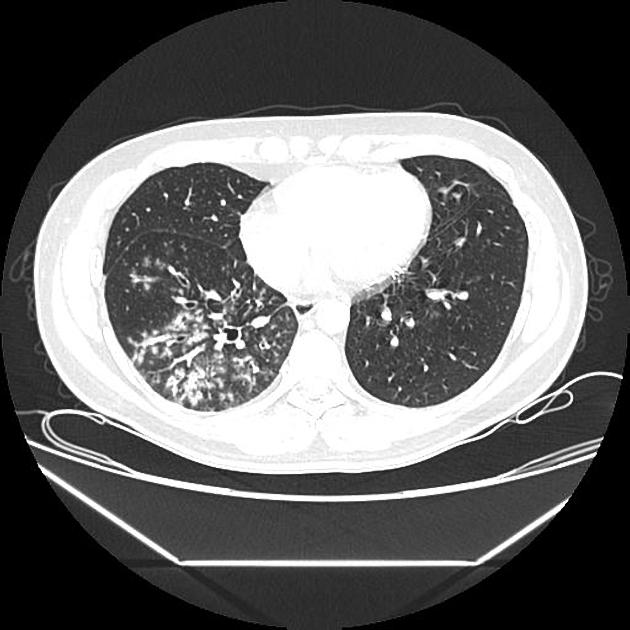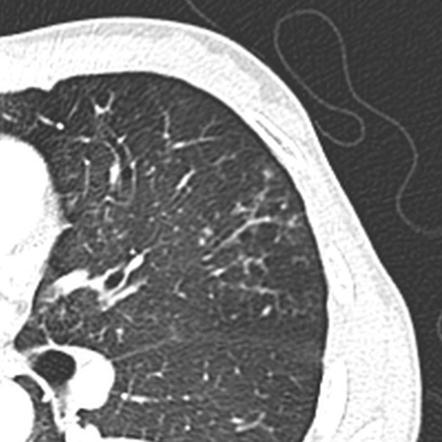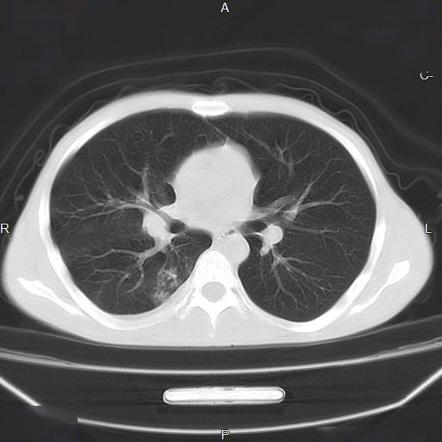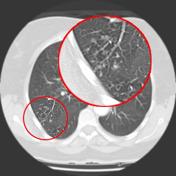tree in bud opacities
Although initially described in 1993 as a thin-section chest CT finding in active tuberculosis TIB opacities are by. However to our knowledge the relative frequencies of the causes have not been evaluated.

Hrct Scan Of The Chest Showing Diffuse Micronodules And Tree In Bud Download Scientific Diagram
Tree in bud opacification refers to a sign on chest ct where small centrilobular nodules and corresponding small branches simulate the appearance of the end of a branch belonging to a tree that is in bud.
. Radiology scientific expert review panel. Mycobacterium avium complex is the most common cause in most series. However BAC can occasionally show tree-in-bud pattern ground-glass opacities or crazy-paving pattern.
The differential diagnosis is lengthy. Tuberculosis many infectious organisms can produce this pattern. The tree-in-bud pattern occurs commonly in patients with endobronchial spread of Mycobacterium.
In radiology the tree-in-bud sign is a finding on a CT scan that indicates some degree of airway obstruction. Bronchial cystazygoesophgeal recesstypical location. Tree in bud opacification refers to a sign on chest ct where small centrilobular nodules and corresponding small branches simulate the appearance of the end of a branch belonging to a tree that is in bud.
Infection Bacterial Infection. Airway-invasive aspergillosis is a mycotic disease caused by Aspergillus species usually A fumigatus. The purpose of this study was to determine the relative frequency of causes of TIB opacities and identify patterns of disease associated with TIB opacities.
In radiology the tree-in-bud sign is a finding on a CT scan that indicates some degree of airway obstruction. TIB opacities represent a normally invisible branches of the bronchiole tree 1 mm in diameter that are severely impacted with mucous pus or fluid with resultant dilatation and budding of the terminal bronchioles 2 mm in diameter1 photo. Other more rare entities that can manifest in this pattern include.
Tree-in-bud TIB opacities are a common imaging finding on thoracic CT scan. 8081 On CT the tree-in-bud pattern manifests as small 24 mm centrilobular well-defined nodules connected to linear branching opacities that. However to our knowledge the relative frequencies of the causes have not been evaluated.
Also to know is what does tree in bud mean. Intravascular pulmonary tumor embolism often occurs in cancers of the breast liver kidney stomach prostate and ovaries and can lead to the tree-in-bud sign in HRCT 214. Although commonly associated with M.
32 rows Tree-in-bud TIB opacities are a common imaging finding on thoracic CT scan. Multiple causes for tree-in-bud TIB opacities have been reported. The presence of atypical findings such as pleural effusion lymphadenopathies consolidations or tree-in-bud appearance in COVID-19 patients should raise a concern about a co-infection or a super-infection.
Multiple causes for tree-in-bud TIB opacities have been reported. Nodular opacities with tree-in-bud appearance can be associated with other changes in lung parenchyma-such as thickening of the bronchial walls consolidations andor areas of. The tree-in-bud sign is a nonspecific imaging finding that implies impaction within bronchioles the smallest airway passages in the lung.
While the tree-in-bud appearance usually represents an endobronchial spread of infection given the proximity of small pulmonary arteries and small airways sharing branching morphology in the bronchovascular bundle a rarer cause of the tree-in-bud sign is infiltration of the small pulmonary arteriesarterioles or axial interstitium 367. However in some cases nodules occurring in relation to centrilobular arteries may mimic the appearance of the tree-in-bud pattern. In fact a recent meta-analysis reported a viral co-infection rate of 7 and 3 for a bacterial one.
3 Aspiration is also a common cause of the tree-in-bud formation. The tree-in-bud sign has been described in cases of acute aspiration 13. In radiology the tree-in-bud sign is a finding on a CT scan that indicates some degree of airway obstruction.
1 It is important for clinicians to remember that this pattern has an extensive. Tree in bud opacification refers to a sign on chest CT where small centrilobular nodules and corresponding small branches simulate the appearance of the end of a branch belonging to a tree that is in bud. In the hospital MTB cannot be missed.
The most common CT findings are centrilobular nodules and branching linear and nodular opacities. What does tree-in-bud opacities mean. These small clustered branching and nodular opacities represent terminal airway mucous impaction with adjacent peribronchiolar inflammation.
Sarcoidosis another common disease typically shows small nodules in perilymphatic distribution. Malignancy can be associated with the tree-in-bud sign. Tree-in-bud TIB opacities are a common imaging finding on thoracic CT scan.
However the most common process leading to this CT appearance is infection. Multiple causes for tree-in-bud TIB opacities an imaging pattern usually seen on chest CT have been reported. This tree-in-bud pattern is due to the presence of caseation necrosis and granulomatous inflammation within and surrounding the terminal and respiratory bronchioles and alveolar ducts reflecting endobronchial spread of tuberculosis.
The tree-in-bud sign is a nonspecific imaging finding that implies impaction within bronchioles the smallest airway passages in the lung. TIB opacities are also associated with bronchiectasis and small airways obliteration resulting in mosaic air trapping. The tree-in-bud sign is a nonspecific imaging finding that implies impaction within bronchioles the smallest airway passages in the lung.
Malignancy can be associated with the tree-in-bud sign. What does tree-in-bud opacities mean. The tree-in-bud sign can be commonly caused by respiratory infections including that of mycobacterial bacterial and viral causes.
The pattern of the tree correlates to an intralobular inflammatory bronchiole and the bud correlates to inflammatory filling in alveolar ducts. The tree-in-bud pattern indicates disease affecting the small airways. 2 However the classic cause of tree-in-bud is Mycobacterium tuberculosis especially when it is active and contagious and associated with cavitary lesions.
11 TIB opacities represent a central imag- Background. Are tree-in-bud nodules cancerous. Uncommonly this pattern can be seen in other entities that cause luminal impaction bronchiolar dilatation or wall thickening including cystic fibrosis immune deficiency inflammatory bowel disease and diffuse panbronchiolitis.
The differential for this finding includes malignant and inflammatory etiologies either infectious or sterile. A young male patient who had a history of fever cough and respiratory distress presented in the emergency departmen. Originally and still often thought to be specific to endobronchial Tb the sign is actually non-specific and is the manifestation of pus mucus fluid or other.

Tree In Bud Sign Lung Radiology Reference Article Radiopaedia Org

Tree In Bud Appearance Radiology Case Radiopaedia Org

Tree In Bud Sign Lung Radiology Reference Article Radiopaedia Org

Tree In Bud Sign And Bronchiectasis Radiology Case Radiopaedia Org

Tree In Bud Sign Lung Radiology Reference Article Radiopaedia Org
View Of Tree In Bud The Southwest Respiratory And Critical Care Chronicles

Pdf Tree In Bud Semantic Scholar

References In Causes And Imaging Patterns Of Tree In Bud Opacities Chest

Tree In Bud Pattern Pulmonary Tb Eurorad

References In Causes And Imaging Patterns Of Tree In Bud Opacities Chest

Chest Ct With Multifocal Tree In Bud Opacities Diffuse Bronchiectasis Download Scientific Diagram

Tree In Bud Sign Lung Radiology Reference Article Radiopaedia Org

Tree In Bud Pattern In Central Lung Cancer Ct Findings And Pathologic Correlation Sciencedirect
